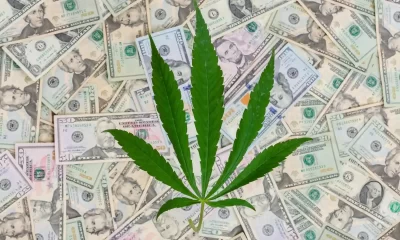Blogs
Reefer Madness 2.0 – Exposing Fake News about Cannabis in the Age of AI, Trump, CNN, and Conservatives

How can you spot an anti-pot article that has no real substance behind it?
Reginald vs the Examiner – Exposing Lies in Modern Reefer Madness
My editor shared this article with me and said, “right up your alley!” and he wasn’t wrong. Published in the Examiner, as the Examiner, meaning, that this is the opinion of the entire organization, some modern Reefer Madness was being spewed and of course – it’s my duty to shine the light on the lies and deception generated through the machinations of prohibition and its associated rhetoric.
While the article isn’t too long, it does provide us with insight to the mind of the prohibitionist and it makes one question, “Who sponsored this article?”
Typically, they have some author attached, but this time it’s simply “The Examiner”.
Nonetheless, let’s analyze the drivel and provide some fresh perspective on the content.
A Quick Summary of the Reefer Madness
The article published in The Examiner attempts to discredit the Drug Policy Alliance’s role in legalizing marijuana and argues that the promised benefits of legalization have not materialized.
The author dismisses the idea that marijuana has medicinal properties and claims it is addictive, especially for young users, and linked to schizophrenia and brain damage. They assert that marijuana legalization has led to increased addiction, crime, and ruined families.
The article also challenges the supposed benefits of legalization, stating that crime has not decreased, tax revenues have fallen short, and marijuana serves as a gateway to more harmful drugs.
The author blames the Drug Policy Alliance – and more importantly George Sorros – for these negative outcomes and warns other states to resist their advocacy for legalization.
However, the article is riddled with biased claims and misinformation.
By starting with an attack on the Drug Policy Alliance’s funding source and dismissing their achievements, the author sets a negative tone from the beginning.
The assertions made about “marijuana’s addictive nature, its direct links to schizophrenia and brain damage, and the notion that it is a gateway drug” are cherry-picked and fail to consider broader scientific research on the subject.
There is no definitive link between any of these things, and in essence, in places where cannabis has been legalized we have seen a decrease in many of these metrics, including a reduction in youth consumption.
The claim that crime has increased with legalization fails to acknowledge the complexities of the relationship between cannabis and crime, and ignores the potential positive effects of regulation and taxation.
For example, it speaks of the “black market” as if it’s a side effect of marijuana legalization.
Marijuana legalization has clearly increased crime. Strict regulations and taxes placed on legal marijuana sellers have created a vast illicit market that easily undercuts the legal market on price. – The Examiner
Except, it didn’t! The vast illicit market has existed for decades and is directly related to prohibition. From Colombia to Mexico, the cartels, street gangs, and your indie growers have all made up the “illicit market” they claim legalization created. However, we know that black market activities existed well before any state legalized cannabis meaning that it is actually the fruits of prohibition itself.
What’s more, it forced the illicit market into the hands of criminals. People willing to break the law and scale their efforts, tend to expand their illicit endeavors and as we’ve seen with Mexican Cartels – they do everything nowadays!
But here comes the kicker from the article;
And because possession is legal, it is virtually impossible to crack down on the illegal market.
The author argues that the illegal cannabis market, run by drug cartels and street gangs (and the indie growers), can’t be stopped because “possession is legal”.
Then what was the excuse when possession was illegal? Not only did prohibition have nearly 50-years of uninterrupted, blank-check, “I’m going to shoot your dog” authority and under this social configuration, cartels grew in size and wealth exponentially.
The Examiner article’s alarmist language and lack of nuanced analysis undermine its credibility and present a biased perspective.
To truly understand the impact of marijuana legalization, a comprehensive examination of scientific research, social and economic data, and the experiences of different states is necessary.
Yet I doubt that the purpose of the article was to actually get to “truth” but rather it’s to shape opinion.
Allow me to get conspiratorial.
Project Mockingbird…
If you haven’t heard about Project Mockingbird let me introduce you to the concept.
Project Mockingbird, as revealed through declassified documents, was an operation in which the CIA sought to shape public opinion by infiltrating and influencing various media organizations. The goal was to ensure that the narrative aligned with the government’s interests. Although the program was officially discontinued in the 1970s, it raises concerns about the potential continuation or evolution of similar efforts in the present day.
We know that as of the pandemic, the “misinformation board” and the “fact checkers” were routinely “fact-checking” truth to suit a government narrative. This isn’t conspiratorial at all.
However, in the world of Chat GPT and similar technology, we need to consider that these programs are more easily conducted than ever before.
Considering this historical context, one might speculate that the article from The Examiner, with its biased and alarmist tone, could be an indirect product of such programs aimed at controlling public perception. While we cannot definitively attribute this article to Project Mockingbird, it is essential to remain vigilant about the potential influence of government agencies or other powerful entities on media outlets.
Maintaining an informed and critical perspective is crucial in today’s media landscape, where disinformation and propaganda can easily permeate public discourse. The lack of author attribution in the article from The Examiner may be a deliberate strategy to obfuscate the true origins of the message and shield it from scrutiny.
To counteract potential manipulation, individuals should actively seek diverse sources of information, fact-check claims, and engage in critical thinking. By being aware of historical instances of media manipulation and staying vigilant, we can better evaluate the validity and credibility of the information presented to us.
While we cannot definitively prove the connection between the article and Project Mockingbird, it is important to question the motives and potential biases behind media content.
An open and informed society depends on the ability of individuals to discern fact from fiction and to challenge narratives that may serve ulterior agendas.
These days, that has become surprisingly difficult even within known spaces such as science and math – that could or could not be racist, according to some.
Before you simply dismiss…stop and think….
Conspiracy Theory has become a weapon to dismiss ideas and has been utilized in recent years for too often.
For example, at the beginning of the Pandemic, to think that the virus originated or leaked from a lab in Wu Han was pure conspiratorial. However, nowadays, the vast majority of the evidence suggests that its exactly where it came from.
There’s a bunch of other conspiracies that turned out to be true in the past as well. Here’s a few of them;
- Operation Northwoods: In the early 1960s, the U.S. Department of Defense proposed a plan to carry out false flag terrorist attacks on American soil to justify military intervention against Cuba. Declassified documents later confirmed the existence of this plan.
- MK-Ultra: In the 1950s and ’60s, the CIA conducted secret mind control experiments under the MK-Ultra program. The agency’s involvement was exposed in the 1970s through congressional investigations and declassified documents.
- Tuskegee Syphilis Study: From 1932 to 1972, the U.S. Public Health Service conducted an unethical study on African American men, withholding treatment for syphilis without their informed consent. The details of this study were revealed in the 1970s, leading to significant reforms in research ethics.
- Iran-Contra Affair: In the 1980s, it was revealed that the U.S. government had secretly facilitated the sale of weapons to Iran to fund Nicaraguan Contra rebels, despite an explicit congressional ban.
- NSA Mass Surveillance: The revelations by whistleblower Edward Snowden in 2013 exposed the widespread surveillance programs conducted by the National Security Agency (NSA) without public knowledge or consent.
Now this isn’t to say that my claim that the Examiner’s Reefer Madness article is evident that it’s from Project Mockingbird or similar programs, I simply provide the above historical events as evidence that they do exist.
In fact, they are far more prominent than you are and mostly not done by governments, but private entities.
Just check out this quote from Transparency.org about the state of the world in relation to their “Corruption Index” and it’s effect on the world;
The global average remains unchanged for over a decade at just 43 out of 100. More than two-thirds of countries score below 50, while 26 countries have fallen to their lowest scores yet. Despite concerted efforts and hard-won gains by some, 155 countries have made no significant progress against corruption or have declined since 2012.
Conflict, security and trouble at the top
Global peace has been deteriorating for 15 years. Corruption has been both a key cause and result of this.
Corruption undermines governments’ ability to protect people and erodes public trust, provoking more and harder to control security threats. On the other hand, conflict creates opportunities for corruption and subverts governments’ efforts to stop it.
Even countries with high CPI scores play a role in the threats that corruption poses to global security. For decades, they have welcomed dirty money from abroad, allowing kleptocrats to increase their wealth, power and destructive geopolitical ambitions. – Transparency.org
Only the naive would believe everything that they hear on the news in this day and age.
The Sticky Bottom Line
I always intend to provide my readers with a nuanced perspective. I know that I am biased towards freedom of consumption. It’s not so much about the drugs itself, as about having the freedom to decide.
This is something that is fundamentally missing from modern society. We’re asked to be more inclusive and tolerant, yet we aren’t allowed to exercise a simple act of consuming a plant without some form of scrutiny.
The potential “psyop” article from the Examiner is nothing but propaganda. Interestingly, it used those very words in the beginning of its article.
However, it’s my hope that with this article, no matter how crazy it became – it made you stop and question your government, your parties, your allegiances.
At the end of the day, all of this corruption, all of these psyops only exist with your participation.
Blogs
Border sales a boost for most marijuana retailers across US

Marijuana sales along state lines are key revenue generators for retail operators in the United States, and new insights suggest a similar business bump along international borders, particularly Mexico.
Data compiled by New York-based wholesale technology platform LeafLink – as well as information gathered from state agencies, quarterly reports and interviews with several cannabis companies – bear that out.
LeafLink analyzed hundreds of ZIP codes at the request of MJBizDaily and found strong links that when new recreational markets open, retailers near borders stock up on inventory significantly more than operators located elsewhere in a state.
Data from the past three years revealed wholesale marijuana products purchased by border stores jumped 140% after the launch of adult-use sales, while retailers located in more interior areas increased purchases by about 80%.
“The growth when a state launches adult-use sales at a border store in terms of purchasing activity is around double the growth of the remainder of the state,” LeafLink Strategy Analyst Ben Burstein told MJBizDaily.
Of course, numerous factors are at play – perhaps none more impactful than the marijuana policies of neighboring states.
That’s why Illinois retailers near Wisconsin, where marijuana possession is illegal, are still attracting Wisconsinites nearly four years after the launch of recreational sales.
There also are retail sales-tax implications, a big reason why St. Louis-areas operators are seeing an influx of shoppers from southern Illinois, where cannabis taxes are at least three times higher than in Missouri.
Meanwhile, border retail in New Mexico is boosting depressed economies along hundreds of miles of its shared borders, drawing stampedes of consumers from neighboring Texas and, more recently, cross-border buyers from Mexico.
Retail shakeup in the heartland
The February launch of adult-use sales in Missouri has caused ripple effects throughout the Midwest.
Missouri holds the rare distinction of bordering eight states, with only Illinois offering recreational marijuana sales.
Missouri’s 6% retail tax on recreational marijuana purchases is also among the lowest in the nation, drawing Illinois consumers across the Mississippi River in droves to buy much cheaper weed.
All in, cannabis sales taxes in neighboring Illinois eclipse 30%, second only to Washington state. And in Chicago, sales taxes can easily top 40%.
Demand is booming in western Missouri, too.
In April, Missouri retailers near the border of Kansas, where marijuana possession is also illegal, told MJBizDaily they were seeing foot traffic increase ninefold after expanding into recreational sales.
The rush of new customers, coupled with cultivation-capacity lags, has led to big spikes in wholesale flower prices and inventory shortages throughout the supply chain.
Retailers, for their part, are trying to keep pace.
To meet consumer demand, wholesale purchases per store in the Kansas City, Missouri, market increased from $97,000 in the quarter before the launch of recreational sales to $491,000 in the quarter after, a whopping 406% jump, according to LeafLink data.
In the St. Louis market, which borders southwestern Illinois, wholesale purchases per store increased nearly 57%, to $610,000, after adult-use sales began.
“The demand’s been bigger than anyone expected,” Burstein said.
A zero-sum game
In marijuana retail, particularly near state borders, it’s a zero-sum game.
The sales boom in the St. Louis market, which has more than 70 stores, has deflated business on the Illinois side of the border, where retailers have lost millions of dollars in sales since Missouri’s adult-use launch, according to quarterly reports and earnings calls.
Top executives at New York-based multistate operator Ascend Wellness Holdings, which has two shops near the Missouri border, cited revenue declines at its southern Illinois stores in recent earnings, saying it has led to suppressed margins that are expected to linger for much of the year.
Florida-based MSO Jushi Holdings, which also operates two Illinois stores near the Missouri border, reported an 8.8% year-over-year revenue decline to $66.4 million in its second quarter, partially attributing the slide to adult-use sales in Missouri.
In an Aug. 11 second-quarter earnings call, Jushi CEO James Cacioppo said total Illinois sales declined 20% from the first quarter and 40% year-over-year.
“I think we under-anticipated the pricing power initially out of the gate that retailers were going to have in Missouri,” Jushi Chief Strategy Director Trent Woloveck told MJBizDaily in an interview.
“The impact was a little bit greater than then we had thought due to that pricing for flower, vapes and infused products.”
In response, Jushi has implemented several initiatives, including adding new promotions and diversifying product SKUs (stock-keeping units) to ease the impact of declines sales in Illinois.
Northern exposure
Market dynamics in northern Illinois, particularly along the Wisconsin border, are a different story.
Wisconsin is among 10 states without a medical or recreational marijuana program.
Illinois counties bordering Wisconsin – including Lake, McHenry, Jo Daviess and Winnebago – accounted for 15.4%, or $239.7 million, of the nearly $1.6 billion in cannabis sales last year in the state, according to a fiscal analysis requested by pro marijuana-legalization lawmakers in Wisconsin.
The Wisconsin Legislative Fiscal Bureau report, which was released in March, cited annual statistics from the Illinois Department of Financial and Professional Regulation.
Moreover, the report estimated about 7.8% of marijuana sales in Illinois in 2022, roughly $36.1 million, were generated by out-of-state residents traveling from Wisconsin.
Under Illinois law, out-of-state residents can only purchase recreational cannabis.
Two of Chicago-based multistate operator Cresco Labs’ 10 stores in Illinois are located near the Wisconsin border: a Sunnyside outlet in South Beloit at the border and one in Rockford, about a 30-minute drive away.
The South Beloit store often draws up to 1,000 daily visitors, according to Cresco’s national retail president, Cory Rothschild – traffic on par with the nation’s busiest marijuana retailers in highly populated areas.
It’s all the more impressive, considering that South Beloit has a population of roughly 8,000 and is more than 40 miles from Madison, the nearest city and Wisconsin’s state capital.
“It’s an extremely high-volume retail location,” Rothschild told MJBizDaily.
“South Beloit and Rockford as well are probably (among the) top dispensaries in the country.”
Maryland
Maryland is the newest recreational cannabis market, with nearly 100 medical marijuana dispensaries having converted to adult-use retail in late June.
While LeafLink wholesale data suggests about a 10% increase in wholesale product purchases statewide after the launch of adult-use sales, some retailers along Maryland’s south and eastern borders are doubling orders to meet demand.
In Elkton, near the Delaware border, stores are ordering about $41,000 in wholesale products per month, up 115% since the launch of recreational sales on July 1.
In the Rockville/Germantown area – outside of Washington DC and near the Virginia and West Virginia borders – monthly wholesale purchases have increased about 42%, to $54,000 per store, since recreational sales began.
Though MMJ dispensaries opened in West Virginia in 2021, the state still has some of the harshest marijuana laws in the country, according to the Marijuana Policy Project.
Meanwhile, Virginia’s adult-use rollout has been put on ice by Republican Gov. Glenn Youngkin.
MSO MariMed’s wholesale business serving retailers in Maryland has benefited from increased demand from neighboring states, according to Jeff Jones, director of operations.
“We have retail customers that are very close to Virginia, Pennsylvania and West Virginia, and I’m sure that’s driving a significant amount of their business,” he said.
The Massachusetts-based company supplies every retailer in the state with its product brands.
MariMed is planning to double its cultivation and canopy space in Maryland, with product from that expansion expected to hit the wholesale and retail markets in the first quarter of 2024, Jones said.
Its retail operation in Annapolis – the state capital is about a 45-minute drive from Pennsylvania or West Virginia – hasn’t experienced the same type of uptick from border business but is still performing well, according to Jones.
A tale of two borders
The small town of Sunland Park, New Mexico, has racked up outsized sales since the state launched recreational retail in April 2022.
The sparsely populated bedroom community is situated across the border from El Paso, Texas, and Jaurez, Mexico, which have a combined population of more than 2.2 million.
That purchasing power has helped Sunland Park’s 88063 ZIP code top the state for per-capita adult-use spending, a sales metric that divides dollars spent for cannabis by population.
Per-person recreational marijuana spending in Sunland Park was $1,044, according to an MJBizDaily analysis of data from the New Mexico Regulation and Licensing Department.
Its 88063 ZIP code also houses two of New Mexico’s leading cannabis stores.
Ultra Health and Everest Cannabis Co. generated nearly $6.1 million in combined sales from August 2022 to February 2023, according to MJBizDaily research.
Because business has been so strong at that Sunland Park store, Ultra Health last summer opened an adjacent location that handles only online orders for pickups.
The majority of its 42 stores were strategically aligned to capture business along New Mexico’s more than 600-mile border with Texas, the second-most-populated state.
“I would say half our business is Texas-related,” Ultra Health CEO Duke Rodriguez told MJBizDaily.
As part of that strategy, the company is planning to open an outlet in Lordsburg with hopes of drawing customers from Mexico, Texas and Arizona.
Mexico border towns share more than commerce, including family, culture and language.
Some residents own commercial properties and homes on either side of the border.
And residents tend to travel freely between Juarez, El Paso and Sunland Park to shop, dine and visit friends and family, according to Rodriguez.
Many also buy regulated marijuana, which might come as a surprise to some industry watchers, especially those unfamiliar with border business in the Southwest.
Though transporting licensed cannabis across the U.S.-Mexico border is barred under federal law, it’s fairly common, industry insiders tell MJBizDaily.
“The product is intended to be consumed within the state of New Mexico and should not cross state or international boundaries,” Ultra Health’s Rodriguez advised.
“The reality is some consumers cross these boundaries intentionally or by not being fully aware of the risk and prohibition.”
Sales in other border communities, such as Clovis and Hobbs – where Ultra Health also has stores – are also outpacing the field, another sign that Texans, and some Mexicans, are crossing the border to purchase marijuana from New Mexico marijuana retailers.
Source: https://mjbizdaily.com/border-sales-a-boost-for-most-cannabis-retailers-across-us/
Blogs
Cannabis Art Is Flourishing On Etsy

Although there is an available and thriving market for cannabis art, most e-commerce websites and platforms prohibit artists from selling art that depicts cannabis.
Is there any section or industry without cannabis influence? It’s starting to look like there isn’t any, as, throughout history, cannabis users have displayed their creative capabilities in various ways. And now cannabis art is flourishing on Etsy
Cannabis users and enthusiasts are some of the most innovative people you’ll ever meet, and their inspiring works of art have been admired for decades. Most of the works created by cannabis enthusiasts have also sparked debate for centuries, dating William Shakespeare’s times.
Cannabis and the creative arts
Research has shown a fantastic connection between cannabis and creativity, an intriguing relationship that is attributed to the plant’s remarkable properties. Cannabis interacts with the human brain through the endocannabinoid system and receptors in the brain.
Extensive works of research show that creative prowess and imagination heighten when users consume cannabis, thus enabling divergent and distinct thought patterns. Hence the reason great men and women like Maya Angelou and Louis Armstrong celebrated the impact of cannabis on their creative careers.A more significant percentage of the creative industry is also full of trailblazers who have affirmed that cannabis is a significant influence on their success. For such artists, marijuana inspires the way they hone their crafts and showcase their ideas.
Despite such a show of artistic brilliance, some artists struggle with finding a place to showcase their works. Why is this the case? Why can’t artist showcase their cannabis-inspired art?
The problem with finding a market showcase
Although there is an available and thriving market for cannabis art, most e-commerce websites and platforms prohibit artists from selling art that depicts cannabis. Some of these merchant shops also flag items such as CBD paraphernalia and insist that such things cannot be sold.
With such restrictions, creative artists fail to get an adequate space to share their creations with the world. Artists feel shut out of the market space, and then COVID-19 happened.
The Coronavirus Pandemic made everything worse for cannabis artists and businesses to maintain operations, which created a disturbing gap in the market.
The Solution: A cannabis-themed marketplace
As the challenge became increasingly worse, two outspoken cannabis advocates co-founded an online marketplace called The Artsy Leaf. Space was set-up as a multi-vendor marketplace to make it possible for artists to display their works.
The co-founders Abbey Weintraub Sklar and Rebecca Goldberg discovered that there were many international craftsmen, women, and artists with products that weren’t shared on any platform. The artists’ products are unique cannabis-friendly items that were mostly scattered on censored tech platforms that limited their exposure to the world.
Goldberg and Skylar understood the importance of an online vendor marketplace created for creators and buyers in the cannabis industry. COVID-19 and its resultant impact was also the inspiration behind an online space.
Initially, it was supposed to be an in-person CBD marketplace, but the pandemic made physical meetings impossible for buying and selling purposes. Hence the reason the co-founders made it an online space with a highly functional website.
The Artsy Leaf
The Artsy Leaf marketplace replaces other online platforms that were too restrictive for those in the cannabis industry. Some of those unfriendly sites didn’t provide room for tagging, describing, and listing CBD products, making it difficult for artists to advertise their products.
But with the Artsy Leaf marketplace, vendors and small business owners have maximum freedom to advertise their cannabis items. The platform also incorporates advertising with SEO consulting and doesn’t hide its processing fees.
The co-founders maintain that their desire to help all cannabis vendors succeed drives the marketplace. The website launched with an initial 14 vendors, and with its viable operational approach, more vendors are expected to join this revolutionary idea.
A virtual cannabis marketplace is what the world needs right now to bridge the gap between artists and buyers. Cannabis-inspired pieces will always remain relevant globally because of how unique and disruptive they can be. The Artsy Leaf is the right incubation place for ideas, purchases, and value exchange.
The future of the online marketplace
The future of the online cannabis marketplace for artists looks promising, and why is this so important? Well, cannabis is gaining a lot of momentum in America, with more states legalizing marijuana more people will gain access to weed, and when they do, they may be inspired to create unique art pieces or be looking to purchase unique cannabis inspired works.
Either way, the cannabis world needs an outlet for artists to share their works, and this is where platforms like the Artsy Leaf become crucial. Other online platforms may start to look into adjusting their policies regarding this issue because this sector is about to explode.
It is time to change the current status quo on the other E-commerce sites not allowing cannabis artists to showcase their genius.
Bottom line
The world is awakening to the ever-increasing potentials of cannabis. Through marketplaces like the Artsy Leaf, cannabis artists and art lovers can meet, interact and sustain the cannabis industry.
Without platforms like these, cannabis-inspired art will gradually decline, and that isn’t good for the cannabis industry at all. We must all continue to encourage the establishments of platforms (online and offline) where artists can thrive. Budding cannabis artists need more places to express themselves, and the Artsy Leaf is a suitable platform.
If you are a cannabis-themed artist, an aspiring one, or a small business owner and you struggle with promoting your work, you can visit The Artsy Leaf.
Source: https://thefreshtoast.com/cannabusiness/cannabis-art-is-flourishing-on-etsy/
Blogs
Beer Lingo, A Guide To Becoming A Better Patron

Bars are wondrous places full of beer, chatter, celebration, ways to get drunk and opportunities to meet friends. But they are also tricky. As with most niche scenes, there is lingo you need to know, terms you should memorize and slang with which you should show facility. What’s Imperial mean? How do you pronounce “weisse?” And how much should I tip my bartender? Hang on, because you’re about to find out the answers to all of these. Here is your beer lingo, a guide to becoming a better patron. BTW, the Slavic word ‘beer’ came from the verb ‘to drink’. Initially, beer was any kind of drink.
Hops
https://giphy.com/embed/3oEduIpVOVcupPXcFG
via GIPHY
Small green pine cone-like buds that grow on vines. Their oils and acids preserve and flavor beer.
Hoppy
The thing snobby people refer to about beer, and what people who hardly ever drink beer say they don’t like. Hoppy is often used as a synonym for the word ‘bitter,’ but there are plenty of beers that use loads of hops and don’t taste the least bit bitter.
Malt
https://giphy.com/embed/3orieWw0snNJFCNxNC
via GIPHY
The sugars used to sweeten beer.
Malty
https://giphy.com/embed/2yxsvbwxQ4TUk
via GIPHY
That syrupy, sweet flavor in beer drunk by amateurs.
Perry
https://giphy.com/embed/d4bm8acp2cuHpLFK
via GIPHY
A cider-like drink made exclusively with pears.
Imperial
https://giphy.com/embed/3o7TKGVVeQK1j0fbe8
via GIPHY
A word out in front of certain beer styles (Stout, IPA) meaning they’re much stronger.
Mead
https://giphy.com/embed/yIXVnzpoNiE0w
via GIPHY
Beer produced from honey, water and yeast.
Ale
https://giphy.com/embed/lAayRqqtfuqju
via GIPHY
Ale is brewed using a warm fermentation method, resulting in a sweet, full-bodied and fruity taste. It is a maltier, top-fermented beer.
Lager
https://giphy.com/embed/dM34XK49ulmDu
via GIPHY
A beer that is effervescent and light in color and body. it is a dry, bottom-fermented drink.
IPA
Stands for India Pale Ale because it was originally brewed in the United Kingdom and shipped to British soldiers in India during colonization (which is still basically happening). It is made with more hops, to give it a stronger flavor. There’s no standardised threshold at which a pale ale becomes an IPA, though.
Cask-Conditioned
https://giphy.com/embed/dg3i5NvtNCr8A
via GIPHY
The process in which a draught beer retains yeast to enable a secondary fermentation to take place in a cask in the pub cellar. Cask conditioned beer is the traditional drink of the British pub, and served properly, it can be among the most subtle and beguiling of beer types.
Fresh Hop
https://giphy.com/embed/3oEdv8lx4icZfRYEPS
via GIPHY
Beer made with recently picked hops that haven’t been dried. It provides distinctively grassy, plant-like, and “green” flavor profiles without the bitterness associated with IPAs and other beers featuring copious dried hops.
Weisse
https://giphy.com/embed/qgqaIJrAgqawE
via GIPHY
Pronounced ‘Vice’ is the counterpart in German for “white,” most commonly used in reference to the sour Berliner type of beer, but also sometimes to the Bavarian type, as in weissbier. Weizen is the German word for “wheat,” most often applied to the Bavarian wheat beer style.
Microbrew
https://giphy.com/embed/l0MYtSjYO26kguz1C
via GIPHY
Compared to macrobreweries, which produce millions of barrels per year, microbreweries produce a relatively small amount of beer—between 1,000 to no more than 15,000 barrels annually. But aside from their size, what makes microbreweries special is that they’re known for brewing specialty beers.
The type of beer you do not use for beer pong unless you make more money than your bartender.
Pint
https://giphy.com/embed/DGWAx8d3IkICs
via GIPHY
The size of glass most beers are served in, and also the thing you dropped and smashed when you were trying to text your Uber driver.
Dive Bar
The kind of bar you actually really like going to, unless you’re trying to impress a date or a friend. It is typically a small, unglamorous, eclectic, old-style drinking establishment with inexpensive yet strong drinks; it may feature dim lighting, shabby or dated decor, neon beer signs, packaged beer sales, cash-only service, and local clientele
BTW, the strongest beer in the world has a strength of 67.5%. It was created in 2017 by the Scottish brewery Brewmeister. The beer is called Snake Venom
Pickup Line
https://giphy.com/embed/EU1obAC38GuWI
via GIPHY
The thing you should never say because it never works.
Tip
https://giphy.com/embed/kfGijLoNvBQ08
via GIPHY
The amount of money you give a bartender after a transaction, which should be more than you initially think to give because A) most bartenders are relatively poor and deserve dough, and B) if you tip a lot you’ll be remembered C) if you tip too little you’ll be remembered D )
How do you want to be remembered?
Patron
https://giphy.com/embed/3oz8xTawWVM7Npb1FS
via GIPHY
Someone who loves the bar they go to, not just someone who is there a lot. If you’re unclear on the distinction, you’ve never loved before.
Bar Napkin
https://giphy.com/embed/xT5LMO10TEI5k1gQAE
via GIPHY
Where much great poetry started.
The Bar
https://giphy.com/embed/PvZ2jLjFofH4Q
via GIPHY
Don’t touch anything behind it.
Hope you enjoyed our beer lingo, a guide to becoming a better patron.
Source: https://thefreshtoast.com/drink/beer-vocab-101-guide-becoming-better-patron/
-

 Business2 years ago
Business2 years agoPot Odor Does Not Justify Probable Cause for Vehicle Searches, Minnesota Court Affirms
-

 Business2 years ago
Business2 years agoNew Mexico cannabis operator fined, loses license for alleged BioTrack fraud
-

 Business2 years ago
Business2 years agoAlabama to make another attempt Dec. 1 to award medical cannabis licenses
-

 Business2 years ago
Business2 years agoWashington State Pays Out $9.4 Million in Refunds Relating to Drug Convictions
-

 Business2 years ago
Business2 years agoMarijuana companies suing US attorney general in federal prohibition challenge
-

 Business2 years ago
Business2 years agoLegal Marijuana Handed A Nothing Burger From NY State
-

 Business2 years ago
Business2 years agoCan Cannabis Help Seasonal Depression
-

 Blogs2 years ago
Blogs2 years agoCannabis Art Is Flourishing On Etsy













